Instructions to disable Flash Player on all browsers
Sometimes the errors involved and originating from Adobe Flash Player are the main reason you feel uncomfortable, or even consume your computer's system resources. Therefore, using Flash Player flexibly or disabling Flash Player is also a good way to get rid of discomfort and frustration when surfing the Web.
Part 1: Learn about Flash Player and Shockwave Player
1. Should I uninstall Shockwave Player or Flash Player?
If you are a tech fan or just a user, you've probably heard about security issues on Adobe Shockwave and Flash Player, especially information related to "dangerous vulnerabilities discovered." on Adobe '. And often you can see that security updates for Flash are released more often than Shockwave.
Users are advised not to install these software on their computers, and if they have been installed, they must regularly update the latest versions to ensure a higher level of security.
If you want to uninstall Adobe Shockwave and Flash Player for some security reason, you can refer to the steps to disable or uninstall Flash Player, Adobe Shockwave on Chrome browser, Internet Explorer. , Firefox or Edge browser in the following section of Network Administration.
Note:
Before proceeding to uninstall, you should check if your computer has Flash and Shockwave installed.
2. How do I know if you have installed Flash Player and Shockwave Player?
If you want to know if you have installed Adobe Flash Player or Adobe Shockwave Player on your computer, open Control Panel, then select Program & Features and you will see Shockwave Player or Flash Player installed on your computer as add -on or extension on the browser add-on manager.
Part 2: Disable Flash and Shockwave on all browsers
1. Disable Flash on Firefox browser
Disabling Flash on Firefox is not as difficult as you think.
First click on the Firefox menu icon (the three dashes icon in the upper right corner) then select Add-ons to open the Firefox Add-ons page.

Next select the Plugins option on the left side of the sidebar.
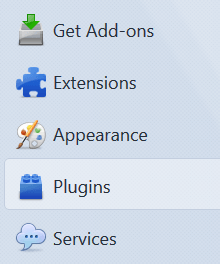
After the Plugins window appears, scroll down to find Shockware Flash and select Never Activate .

Finally proceed to restart Firefox browser. From now on Flash has been disabled on your Firefox browser.
2. Disable Flash on Chrome browser
By default on Chrome browser, Flash is disabled. In case of necessity you can re-enable Flash.
However, if you want to completely disable Flash, you can follow the steps below:
First enter the chrome: // plugins URL in the address bar to open the Chrome Plugins page.
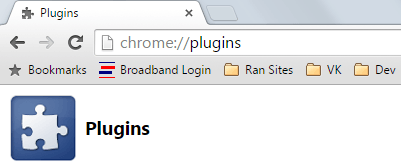
Here, scroll down to find Adobe Flash Player , then click Disable.
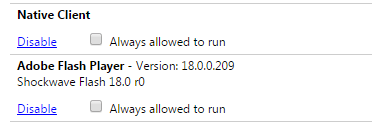
Finally proceed to restart Chrome browser. From now on Flash has been disabled on your Chrome browser.
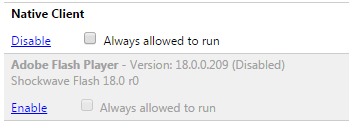
3. Disable Flash on Internet Explorer
To disable Flash in Internet Explorer, first open the Settings menu (Settings) by clicking on the small jag icon in the top right corner, then select Manage Add-ons to open the Manage Add- window. ons.

At the Manage Add-ons window, select the Toolbars and Extensions option. Next find the Shockwave Flash Object extension and right-click it and select Disable.

From now on Flash has been disabled on your Internet Explorer browser.
4. Disable Flash on Opera browser
To disable Flash in Opera browser, first click Opera in the top left corner, then select the Settings option (Settings) to open the Opera Settings page (Opera Settings).
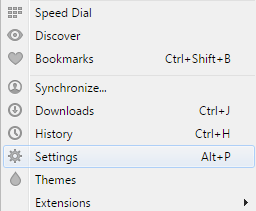
Here you select Websites (located on the left side of the sidebar), then select Manage individual plugins under the Plugins section.

After the Plugins page appears, find Adobe Flash Player and click Disable.
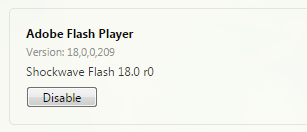
From now on Flash has been disabled on your Opera browser.
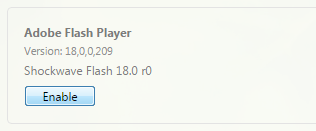
5. Disable Flash on Safari browser
To disable Flash on the Safari browser, click on the Settings icon in the top right corner and select the Preferences option to open the Preferences window.
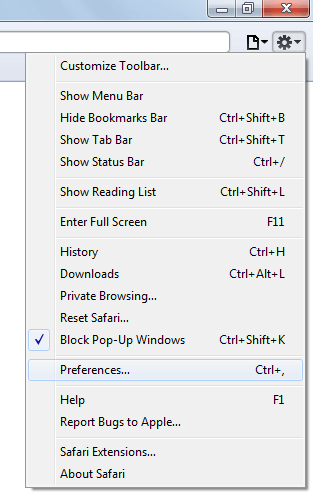
Here you find the Security tab, then uncheck Enable Plug-ins and close the Preferences window.
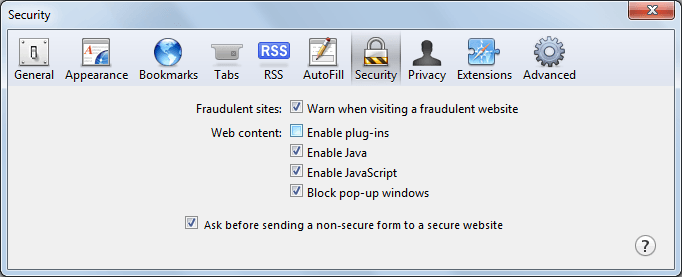
From now on Flash has been disabled on your Safari browser.
6. Disable Adobe Flash Player on Edge browser
To disable Adobe Flash Player on the Edge browser, on the Edge browser window, click on the 3 dots icon in the top right corner of the screen, then select Settings.
Next scroll down to find and select View advanced settings.
On the next window, look for an option called Use Adobe Flash Player. By default this option is set to ON. Your task is to switch the option state to OFF.
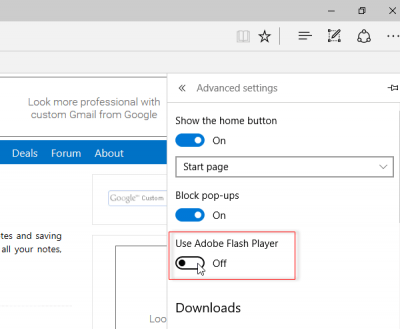
You can refer to some articles below:
-
Instructions for changing the default web browser in Windows 7
-
Chrome is still the most popular browser with 34% market share
-
44 shortcuts are useful on all browsers
Good luck!
You should read it
- Instructions on how to install Adobe Flash Player on your computer
- Instructions for troubleshooting Flash Player crash (crash) in the browser
- How to block Flash from accelerating Chrome browser
- How to prevent GIFs from automatically playing in the browser
- How to Unblock Flash Player
- How to check the Adobe Flash Player version in the browser
- Instructions for updating the latest Adobe Flash Player version
- Fix the abrupt Flash Player error on Google Chrome
May be interested
- New improvements in Adobe Flash Player 10.1
 adobe flash player is software used for developing interactive websites, videos, games on pcs and mobile phones.
adobe flash player is software used for developing interactive websites, videos, games on pcs and mobile phones. - How to install Adobe Flash Player on CentOS 8
 adobe flash player can also be installed on many types of operating systems, including windows, macos, linux / unix and android. in this article, you will learn how to install adobe flash player on centos 8 using terminal.
adobe flash player can also be installed on many types of operating systems, including windows, macos, linux / unix and android. in this article, you will learn how to install adobe flash player on centos 8 using terminal. - Fix the abrupt Flash Player error on Google Chrome
 google chrome is the default browser for many users because it is easy to use and has many features. however, there are some errors on google chrome that users cannot find a way to fix. one of the problems is that the flash player is suddenly stopped for unknown reasons. this happens when you are playing a video that requires shockwave flash player.
google chrome is the default browser for many users because it is easy to use and has many features. however, there are some errors on google chrome that users cannot find a way to fix. one of the problems is that the flash player is suddenly stopped for unknown reasons. this happens when you are playing a video that requires shockwave flash player. - What to do when the Macbook has a Flash Player error not showing up?
 many users of safari's macbook often encounter browser error flash, black screen when watching youtube ... how to fix this error?
many users of safari's macbook often encounter browser error flash, black screen when watching youtube ... how to fix this error? - Instead of killing Flash, we should save it for posterity
 adobe has decided to launch flash player in 2020, but not only has important implications in internet history, flash also contains a lot of content that we probably won't want to leave.
adobe has decided to launch flash player in 2020, but not only has important implications in internet history, flash also contains a lot of content that we probably won't want to leave. - How to Update Adobe Flash Player
 this article shows you how to update adobe flash player on windows, mac or linux computers. although adobe flash player usually automatically updates the program if you have installed it according to the default settings, you can still check and install the updated version (if available).
this article shows you how to update adobe flash player on windows, mac or linux computers. although adobe flash player usually automatically updates the program if you have installed it according to the default settings, you can still check and install the updated version (if available). - Adobe said goodbye to Flash Media Player by 2020
 in a joint statement with apple, facebook, google, microsoft and mozilla, adobe announced plans to stop supporting adobe flash media player by 2020.
in a joint statement with apple, facebook, google, microsoft and mozilla, adobe announced plans to stop supporting adobe flash media player by 2020. - 5 simple steps to activate Flash in Chrome
 the following article will show you how to enable adobe flash player in chrome and better still keep flash disabled until you click on it.
the following article will show you how to enable adobe flash player in chrome and better still keep flash disabled until you click on it. - The painful and prolonged death of Flash
 if you have been using the internet for a long time, not only have you used flash in recent years. historically, this platform has become a popular platform on the web and without smartphones it can still last today.
if you have been using the internet for a long time, not only have you used flash in recent years. historically, this platform has become a popular platform on the web and without smartphones it can still last today. - Flash Player 10: Bringing the movie experience to the web
 yesterday (may 15), adobe system officially released the first test version of flash player 10 with many new features to allow designers and web developers to create special effects or bring them to web browsing experience 'like watching movies' for parachutes
yesterday (may 15), adobe system officially released the first test version of flash player 10 with many new features to allow designers and web developers to create special effects or bring them to web browsing experience 'like watching movies' for parachutes










 This is how to reduce Internet traffic on Google Chrome
This is how to reduce Internet traffic on Google Chrome Steps to fix 'Your Preferences can not be read' in Chrome browser
Steps to fix 'Your Preferences can not be read' in Chrome browser How to share websites with audio on Google Chrome
How to share websites with audio on Google Chrome How to disable Containers feature on Firefox browser?
How to disable Containers feature on Firefox browser? How to restore Chrome, Firefox, IE browser to the default state?
How to restore Chrome, Firefox, IE browser to the default state?